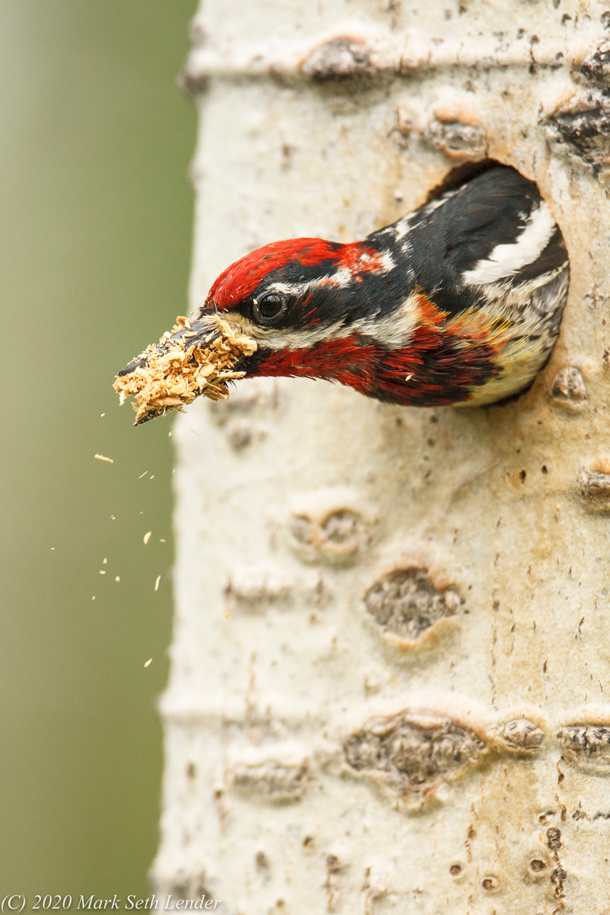Field Note: Sap-Iens: Yellow-Bellied Sapsuckers
Published: May 3, 2020
By Mark Seth Lender

The carpenter at work. (Photo: © Mark Seth Lender)
Living on Earth's Explorer-in-Residence Mark Seth Lender expands on his observations of yellow-bellied sapsucker parents making a comfortable home for their young.
Woodpeckers are cavity nesters. If you see a perfectly round hole in the side of a tree, chances are there is or was a woodpecker nest inside. Unlike the iconic woven construct we usually mean by “nest,” woodpecker houses don’t give, and accommodating a growing family is big work. And it does not seem that work can be done in advance. In the still-cold season when nesting begins, in order for first the eggs and later the young to keep warm a nest cavity probably needs to start off as small as possible. Then the race is on as the chicks grow and more and more space is required.
Every time the sapsuckers exited the nest they would look at me. A crested grebe, on her bundle of reeds out in the very middle of the pond where she was safe enough from most things that might come to harm her, even she turned to look, over her shoulder and across her folded wings. As did the other birds in the vicinity. And more than once.
They made it clear enough, they did not want me to be there. But this I came to understand only in retrospect.
The tree the yellow-bellied sapsuckers had chosen was just off a paved road, in a park, where people came not in large numbers but with some frequency. I thought the birds were tolerant and that was all there was to it. Now I see it differently. In their industry the sapsuckers were too much involved in their necessary work to be intolerant. And the historical truth, apparent to me now is that they were always there, in an intergenerational endeavor (the living equivalent of building cathedrals or pyramids), insuring the unbroken line of survival of their respective kind; and by that work, immobilized. We crowded in. Right on top of them. The way we always do.
That look the sapsuckers gave me was as I had supposed a making sure that I would do no harm, but it was also a request to undo some of the harm I’d done already. By leaving.
Back to Mark Seth Lender Field Notes
Links
Listen to the original "Sap-Iens: Yellow-Bellied Sapsuckers" essay
Living on Earth wants to hear from you!
Living on Earth
62 Calef Highway, Suite 212
Lee, NH 03861
Telephone: 617-287-4121
E-mail: comments@loe.org
Newsletter [Click here]
Donate to Living on Earth!
Living on Earth is an independent media program and relies entirely on contributions from listeners and institutions supporting public service. Please donate now to preserve an independent environmental voice.
NewsletterLiving on Earth offers a weekly delivery of the show's rundown to your mailbox. Sign up for our newsletter today!
 Sailors For The Sea: Be the change you want to sea.
Sailors For The Sea: Be the change you want to sea.
 The Grantham Foundation for the Protection of the Environment: Committed to protecting and improving the health of the global environment.
The Grantham Foundation for the Protection of the Environment: Committed to protecting and improving the health of the global environment.
 Contribute to Living on Earth and receive, as our gift to you, an archival print of one of Mark Seth Lender's extraordinary wildlife photographs. Follow the link to see Mark's current collection of photographs.
Contribute to Living on Earth and receive, as our gift to you, an archival print of one of Mark Seth Lender's extraordinary wildlife photographs. Follow the link to see Mark's current collection of photographs.
 Buy a signed copy of Mark Seth Lender's book Smeagull the Seagull & support Living on Earth
Buy a signed copy of Mark Seth Lender's book Smeagull the Seagull & support Living on Earth

